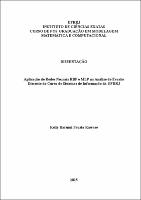| ???jsp.display-item.social.title??? |


|
Please use this identifier to cite or link to this item:
https://tede.ufrrj.br/jspui/handle/jspui/3216| ???metadata.dc.type???: | Dissertação |
| Title: | Aplicação de redes neurais RBF e MLP na análise de evasão discente do curso de Sistemas de Informação da UFRRJ |
| Other Titles: | Application of neural networks RBF and MLP in student evasion analysis of the Information Systems Course of UFRRJ |
| ???metadata.dc.creator???: | Kawase, Kelly Harumi Fausta  |
| ???metadata.dc.contributor.advisor1???: | Silva, Robson Mariano da |
| ???metadata.dc.contributor.referee1???: | Machado, Lígia Cristina Ferreira |
| ???metadata.dc.contributor.referee2???: | Gonçalves, Reinaldo Bellini |
| ???metadata.dc.description.resumo???: | A evasão escolar é um problema complexo, por reunir diversos fatores que influenciam na decisão do aluno em permanecer ou não no curso. Identificar as características envolvidas neste processo possibilita traçar o perfil dos alunos propensos à evasão para poder tomar medidas eficazes. Segundo a literatura, os cursos na área de Tecnologia da Informação vêm apresentando altos índices de evasão. Não obstante disto, o curso de Sistemas de Informação da UFRRJ vem apresentando índices preocupantes. Dentre os diversos trabalhos encontrados na literatura para predizer a evasão no Ensino Superior do Brasil, a utilização de técnicas computacionais vem despertando interesse dos pesquisadores, precisamente Redes Neurais Artificiais ARTMAP Fuzzy, Funções de Base Radial (RBF) e Redes Bayesianas, que vem mostrando bons resultados na predição de evasão discente em Instituições de Ensino Superior. O objetivo dessa dissertação é propor um sistema inteligente baseado em redes neurais de Perceptron de Múltiplas Camadas (MLP) e Funções de Base Radial (RBF) na análise de evasão discente do curso de Bacharel em Sistemas de Informação da UFRRJ. O conjunto de dados utilizados corresponde a 148 amostras de alunos matriculados no curso. Para tal estudo foi considerado a evasão até o 3º período, onde foram utilizadas as seguintes variáveis: gênero, origem escolar, desempenho nas disciplinas específicas do 1º período, distância, tempo de ingresso entre o Ensino Médio e o Ensino Superior, desempenho no ENEM (Exame Nacional do Ensino Médio), estado civil e situação com relação à evasão. Foram realizadas 100 simulações, sendo selecionadas as 25 melhores. Os resultados obtidos pelas redes RBF e MLP mostram ser promissores na análise de evasão discente do curso. Sendo que a rede RBF apresentou melhor desempenho (acurácia = 91,03%) do que o modelo MLP, com diferença significativa (p valor<0,05) entre os resultados dos modelos |
| Abstract: | The school dropout is a complex problem, which gathering various factors that influence the decision of the student to stay or not in the course. The identification of the characteristics involved in this process turned it possible to analyse the profile of the students prone to evasion, and thereby to take effective action. According to the literature, courses in Information Technology area have shown high dropout rates. However, the course of Information Systems of UFRRJ has shown alarming rates. Among the many studies in the literature to predict dropout in higher education in Brazil, the use of computational techniques has aroused the interest of researchers, precisely Artificial Neural Networks ARTMAP Fuzzy, Radial Basis Function (RBF) and Bayesian networks, which has been showing good results in predicting student dropout in higher education institutions. The objective of this dissertation is to propose an intelligent system based on Multilayer Perceptron (MLP) and Radial Basis Function (RBF) in student evasion analysis of the course of Bachelor of Information Systems UFRRJ. The used data set corresponds to 148 samples of students enrolled in the course. For such a study was considered evasion to the 3rd period , where the following variables were used: gender, school origin, performance in the specific subjects of the 1st period, distance, time between high school and higher education, performance in ENEM (National Secondary Education Examination), civil status and situation regarding evasion. It were performed 100 simulations, being selected the top 25. The results obtained by the RBF and MLP networks prove to be promising in the course Student dropout analysis. Since the RBF network performed better (accuracy = 91.03%) than MLP model, with a significant difference (p value<0.05) between the results of the models. |
| Keywords: | Evasão Sistemas de Informação Redes Neurais Artificiais Evasion Information Systems Artificial Neural Networks |
| ???metadata.dc.subject.cnpq???: | Matemática |
| Language: | por |
| ???metadata.dc.publisher.country???: | Brasil |
| Publisher: | Universidade Federal Rural do Rio de Janeiro |
| ???metadata.dc.publisher.initials???: | UFRRJ |
| ???metadata.dc.publisher.department???: | Instituto de Ciências Exatas |
| ???metadata.dc.publisher.program???: | Programa de Pós-Graduação em Modelagem Matemática e Computacional |
| Citation: | KAWASE, K. H. F. Aplicação de redes neurais RBF e MLP na análise de evasão discente do curso de Sistemas de Informação da UFRRJ. 2015. 59 f. Dissertação (Mestrado em Modelagem Matemática e Computacional) - Instituto de Ciências Exatas, Universidade Federal Rural do Rio de Janeiro, Seropédica-RJ, 2015 . |
| ???metadata.dc.rights???: | Acesso Aberto |
| URI: | https://tede.ufrrj.br/jspui/handle/jspui/3216 |
| Issue Date: | 5-Oct-2015 |
| Appears in Collections: | Mestrado em Modelagem Matemática e Computacional |
Files in This Item:
| File | Description | Size | Format | |
|---|---|---|---|---|
| 2015 - Kelly Harumi Fausta Kawase.pdf | Kelly Harumi Fausta Kawase | 1.41 MB | Adobe PDF |  Download/Open Preview |
Items in DSpace are protected by copyright, with all rights reserved, unless otherwise indicated.




